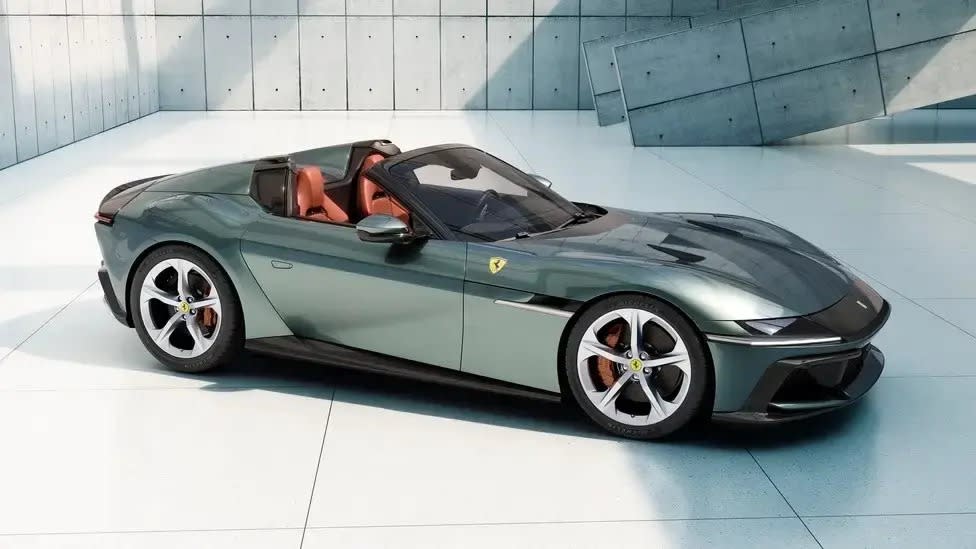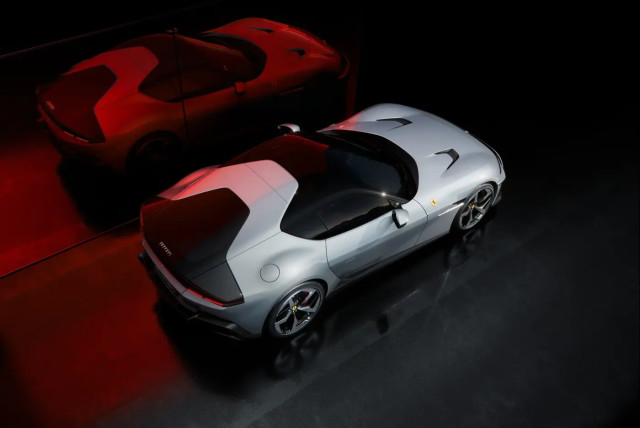Only Ferrari can dare to present a car like this in 2024

Ferrari's new 12CILINDRI GT car is fast and non-electric with a classic engine setup. It hits 0-100 km/h in 2.9 seconds, reaches 340 km/h, and its price in shekels will be revealed later.
For several months now, Ferrari's marketing machine has been releasing tidbits of information about a new model that will be launched in May. On Thursday evening, Friday morning for us, as part of celebrations in Miami on the occasion of Ferrari's 70th anniversary in the USA, it will debut to the world.
The name says it all, "Ferrari dodici cilindri" (12 cylinders). No turbo, no electric motors and batteries around. In the age of climate crisis and fuel savings, this car is as politically correct as Donald Trump. The 12-cylinder models have always been considered the true Ferraris. The first engine the company introduced to the private market was a 12-cylinder and that was the configuration of Formula 1 engines that the Italian company was so closely associated with.
So, the heir to the 812 Superfast is equipped precisely with such an engine, with a displacement of 6,500 cc, one that offers 80% of the torque already from 2,500 rpm, with a redline at 9,500 high rpm, engines that we were not used to seeing in a new car from the nineties, and here the engine moves slightly back from the front axle for the sake of weight distribution and stability, with a slight bias towards the rear: the weight distribution stands at 48.4% front and 51.6% rear. There is also a dual-clutch automatic gearbox, 8 new speeds, promising a 30% reduction in shift times.
Similar to the 296 here there is engine sound engineering to the driver's compartment, so you can hear your car perfectly. In order to comply with noise and emissions regulations, the exhaust emits only 70 decibels of noise rearward outward. It would not be surprising if most people who buy one will replace the exhaust at the first opportunity.
Design: Every few years Ferrari chooses a new model to launch a new design language, continuing to develop it for new models. In the 12 C there is a new, different line, reminiscent of the classic 365 Daytona, produced between 1965 and 1973, during the era when the company was directly controlled by Enzo Ferrari before selling control to Fiat in 1970.
Like with the Daytona, here too there is a wide front and sloping rear, covering the engine lengthwise, and a driver compartment that only starts after the midpoint line. The outlining lines are very clean, elongated, monolithic, with smooth transitions, where the change between parts is only in color or material. The rear wing and diffuser, the lower air splitter, are very minimalist and seem to be floating in the air. The design is elevated with developments taken from Formula 1, with an adaptive rear wing, assistance in handling from the rear wheels, and the use of aerodynamics to create downforce.
The weight has slightly increased, by 35 kg, to 1,560 kg, and it still maintains a dreamy power-to-weight ratio of 1.88 kg per horse power. This is a long car (4.73 meters), wide (2.17 meters), and tall (1.29 meters). The wheelbase stretches along 2.7 meters and the cargo compartment has a volume of 270 liters.
Passenger compartment: Inside, you can encounter all the advancements of Ferrari in recent years. The 12 C is a two-seater, not the car you would take the kids to school in, with defined areas for both the driver and the passenger, almost separated. Similar to Purosangue or Roma, it seems like a lot has been invested to create a comfortable and functional yet very modern experience: there is a 10.25-inch multimedia screen, a 15.6-inch driver's instrument panel that displays all the system data and settings, and a third screen, 8.8 inches for the passenger. The gears are clearly in an H shape, and the steering wheel contains everything needed to drive and easily switch driving modes. On the sides, the gearshift paddles are fixed in a Formula 1 style, with the engine start/stop button in the center. There is also a Bowers & Wilkins sound system, 15 speakers with a power of 1,600 watts, including all the advanced sound technologies. A bit wasteful in a car that already has an engine with such a sound.
Performance: Official figures are 2.9 seconds from 0 to 100 km/h, 7.9 seconds from 0 to 200 km/h, and a maximum speed of 340 km/h. A full stop from 100 km/h will take 31.4 meters, and from 200 km/h - 122 meters. Fuel consumption data is "not yet available," but a hint provides the fuel capacity: 92 liters.
There is still no arrival date for Israel, even if you order it now. It seems that the delivery date will not be before the end of 2025. In a local price estimate abroad, one can expect a higher amount than Purosangue, perhaps more than NIS 6M, with an additional 10% for the convertible version, where the roof folds electrically in 14 seconds. At least the price includes a warranty and service for seven years.
In conclusion, whether you choose to take a two-hour trip in a rental for a few hundred euros, or rent one for a day for a few thousand, or if you prefer to buy one abroad without paying nearly three times as much in your country, there is a model here that is going to give us a pure Ferrari experience.
Jerusalem Post Store
`; document.getElementById("linkPremium").innerHTML = cont; var divWithLink = document.getElementById("premium-link"); if (divWithLink !== null && divWithLink !== 'undefined') { divWithLink.style.border = "solid 1px #cb0f3e"; divWithLink.style.textAlign = "center"; divWithLink.style.marginBottom = "15px"; divWithLink.style.marginTop = "15px"; divWithLink.style.width = "100%"; divWithLink.style.backgroundColor = "#122952"; divWithLink.style.color = "#ffffff"; divWithLink.style.lineHeight = "1.5"; } } (function (v, i) { });




